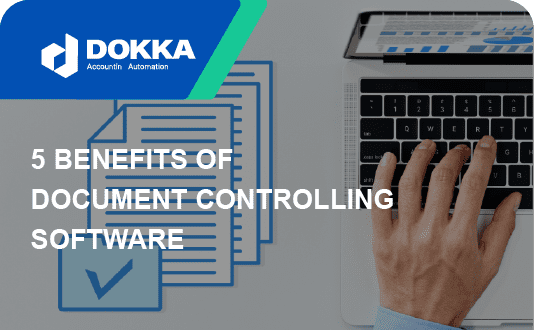In the modern business of today, emphasis has increased significantly around efficiency, better data, and the protection of important documentation. Regarding the last point, document control has come to the fore as a vital procedural system that said modern business must get right. Why? Because good document control reduces costly errors, allows a management contingent to gain quicker access to important documents, and disseminate these to relevant stakeholders in teams. What’s more, an established document control workflow automates the process, so that important timelines are never deviated from.
It’s essential then, that you bring a powerful document controlling method into your business. DOKKA’s document control workflow is such a method. Before you explore our service’s features, though, here’s a breakdown on why document controlling is the necessary change that every business that’s growing and evolving must integrate.
What is document controlling software?
Document controlling software is a system that helps businesses manage their electronic and physical documents. It ensures that only the latest versions of documents are being used and that all team members have access to the most up-to-date information. Document control also helps businesses keep track of their assets and helps to prevent data loss.
Benefits of document controlling software
- It can help ensure regulatory compliance
- It improves communication and collaboration between team members
- It prevents data loss and corruption
- It helps keep track of company assets
- It can improve customer service
There are many processes that document controlling system simplifies and makes more efficient. Here are just a few:
- Document control procedures help to ensure that documents are properly managed and controlled throughout their life cycle.
- Document control workflow helps to ensure that documents are properly routed and approved.
- Document control methods help to ensure that documents are properly stored and retrieved.
- Document control and records management help to ensure that documents are properly archived and disposed of.
All of these things help to protect the business from legal liabilities, loss of information, and other risks. But beyond all of that, document controlling simply makes good business sense. It helps businesses to run more smoothly and efficiently, by ensuring that everyone is working with the most up-to-date versions of documents and that all changes are tracked and approved. Document control can save businesses time and money and help to avoid potential problems down the road.
So, if you’re not already automating your document controlling processes in your business, now is the time to start. It will help you to avoid many potential problems, and it will make your business run more smoothly overall.
Here are five reasons why document control is essential for businesses:
- It can help ensure regulatory compliance
- It improves communication and collaboration between team members
- It prevents data loss and corruption
- It helps keep track of company assets
- It can improve customer service
To recap, then, an effective document control system can help businesses meet their regulatory obligations, improve communication between employees, prevent data loss, and keep track of company assets. Document control is essential for businesses that want to operate efficiently and effectively.
What can businesses do to improve document control system?
There are many ways businesses can improve their document control system. Document control is the process of handling and managing documents throughout their lifecycle, from creation to destruction. Essentially, though improving your business’s document control system specifically by automating it with software, means improved efficiency and accuracy, while reducing costs.
Here are a few other tips to implement alongside automation, to streamline the entire procedure:
- Define roles and responsibilities. Document control should be assigned to specific individuals within your organisation. These individuals should be responsible for creating, revising, and approving documents.
- Create document control procedures. Document control procedures should be designed to ensure that documents are properly created, revised, and approved before they are distributed.
- Implement a document control workflow. Document control workflow should be designed to route documents to the appropriate individuals for review and approval.
- Use document control methods to track and monitor changes to documents. Document control methods can help businesses track and monitor changes to documents.
- Use document control and records management to keep track of documents and maintain compliance with regulatory requirements.
Document controlling software is an important part of any business and should be given the attention it deserves. By taking the time to improve your document control system and implement a smart automated structure, like DOKKA’s accounting automation add-on, you can reap the benefits of increased efficiency and accuracy, while reducing costs.








